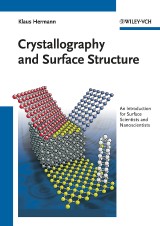Details
Crystallography and Surface Structure
An Introduction for Surface Scientists and Nanoscientists1. Aufl.
|
97,99 € |
|
| Verlag: | Wiley-VCH |
| Format: | EPUB |
| Veröffentl.: | 08.04.2011 |
| ISBN/EAN: | 9783527633319 |
| Sprache: | englisch |
| Anzahl Seiten: | 298 |
DRM-geschütztes eBook, Sie benötigen z.B. Adobe Digital Editions und eine Adobe ID zum Lesen.
Beschreibungen
A valuable learning tool as well as a reference, this book provides students and researchers in surface science and nanoscience with the theoretical crystallographic foundations, which are necessary to understand local geometries and symmetries of bulk crystals, including ideal single crystal surfaces. The author deals with the subject at an introductory yet mathematically sound level, providing numerous graphic examples to keep the math in context. The book brings together and logically connects many seemingly disparate structural issues and notations used frequently by surface scientists and nanoscientists. Numerous exercises of varying difficulty, ranging from simple questions to small research projects, are included to stimulate discussions about the different subjects.<br>
1. Introduction<br> 2. Bulk crystals, 3-dimensional lattices<br> 2.1. Basic definitions<br> 2.2. Representation of bulk lattices<br> 2.3. Periodicity cells of lattices<br> 2.4. Lattice symmetry<br> 2.5. Neighbor shells<br> 2.6. Quasicrystals<br> Exercises<br> 3. Crystal layers, 2-dimensional lattices<br> 3.1. Basic definitions, Miller indices<br> 3.2. Reciprocal lattice<br> 3.3. Netplane-adapted lattice vectors<br> 3.4. Symmetrically appropriate lattice vectors, Minkowski reduction<br> 3.5. Miller indices for cubic lattices<br> 3.6. Alternative definition of Miller indices, hexagonal Miller-Bravais indices<br> 3.7. Symmetry properties of netplanes<br> 3.8 Crystal systems and Bravais lattices in two dimensions<br> 3.9 Crystallographic classification of netplanes<br> Exercises<br> 4. Ideal single crystal surfaces<br> 4.1. Basic definitions, termination<br> 4.2. Morphology of surfaces, stepped and kinked surfaces<br> 4.3. Miller index decomposition<br> 4.4. Chiral surfaces<br> Exercises<br> 5. Real crystal surfaces<br> 5.1. Surface relaxation<br> 5.2. Surface reconstruction<br> 5.3. Facetting<br> Exercises<br> 6. Adsorbate layers<br> 6.1. Definition and classification<br> 6.2. Wood notation of surface geometry<br> 6.3. Symmetry domain formation<br> Exercises<br> 7. Experimental analysis of real crystal surfaces<br> 7.1. Experimental methods<br> 7.2. The NIST Surface Structure Database (SSD)<br> Exercises<br> 8. Nanotubes<br> 8.1. Basic definition<br> 8.2. Nanotubes and symmetry <br> 8.3. Complex nanotubes, examples<br> Exercises<br> Appendices:<br> A Mathematics of the Wood notation<br> B Mathematics of the Minkowski reduction<br> C Some details of number theory<br> D Some details of vector calculus and linear algebra<br> E Parameter tables of crystals<br> F Relevant websites<br>
Klaus Hermann is a research group leader at the Fritz-Haber Institute and staff member of the Physics department of the Free University Berlin (Germany). He obtained a PhD in Physics from the University Clausthal (Germany), worked as postdoc in Mexico and the USA before being appointed Professor at the University Clausthal. He was visiting professor in the USA, Austria, Poland, Spain and in Hong Kong. Klaus Hermann has (co-)authored 150 scientific publications, two books, two scientific movies, and different software projects on various subjects in surface science, catalysis, quantum chemistry, and computer science. He is co-author of the NIST Surface Structure Database.<br> http://www.fhi-berlin.mpg.de/th/member/hermann_k.html<br>
A valuable learning tool as well as a reference, this book provides students and researchers in surface science and nanoscience with the theoretical crystallographic foundations, which are crystals, including ideal single crystal surfaces. The author deals with the subject at an introductory yet mathematically sound level, providing numerous graphic examples to keep the math in context. The book brings together and logically connects many seemingly disparate structural issues and notations used frequently by surface scientists and nanoscientists. Numerous exercises of varying difficulty, ranging from simple questions to small research projects, are included to stimulate discussion about the different subjects. <p><b>From the contents:</b></p> <ul> <li> <div>Introduction</div> </li> <li> <div>Bulk Crystals, 3-dimensional Lattices</div> </li> <li> <div>Crystal Layers, 2-dimensional Lattices</div> </li> <li> <div>Ideal Single Crystal Surfaces</div> </li> <li> <div>Real Crystal Surfaces</div> </li> <li> <div>Adsorbate Layers</div> </li> <li> <div>Experimental Analysis of Real Crystal Surfaces</div> </li> <li> <div>Nanotubes </div> </li> </ul>


















